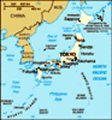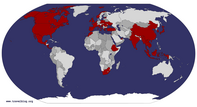Advertisement
Published: October 14th 2017
It's noticeable as soon as you disembark the train from Tokyo. Things just look a little different. Everyone's shirt is not fully tucked in. People are a little rounder and some are a few weeks past due for a haircut. There is litter on the street. Not a lot, but after the scrubbed streets of Kyoto and Tokyo, it is visible. A couple of older guys stand under the "No Smoking" signs, sharing a story and puffing away. Both have on baseball hats and looked like they didn't spend a lot of time choosing their wardrobe today. The smell of fried food drifts from somewhere nearby. People tend to wander, or maybe just walk with a little less purpose here. Voices are a little louder and everyone doesn't stay in line. It's immediately clear you have arrived in a different part of Japan. Welcome to Osaka.
We struggled to choose a 3rd city for our visit to Japan. Kyoto had been an obvious choice. History, culture and sophistication. Tokyo was an easy decision. Modern, stylish and fast paced. We thought about something to the north or in the green countryside. Maybe something in the southern islands. Our budget

 Namba Park
Namba Park
Mall with nice architectureis pretty tight and we were feeling pinched after rent, food and transportation. We really needed to find a place that had a lot to do, good transportation and wouldn't require too many moves.
We had begun our travels in Japan at Osaka's huge Kansai Airport a couple of months earlier. Normally we are one way travelers, but this time had chosen a round trip from San Francisco. So eventually we were going back to Osaka. Perhaps we could locate ourselves in Osaka and save some time and money on connections later in the month. Could we find enough to keep us occupied for a whole month?
Osaka is known for two things in Japan. Business and food. A common greeting in Osaka is "Have you made any money today"?. Even in a country as obsessed with food as Japan, Osaka stands out as being a mecca for foodies. It is said that while a person from Tokyo will spend his last dollar on fashion, a person from Osaka will always opt for food. One restaurants motto is "Eat until you are bankrupt!". Maybe this explained the slightly expanded beltlines that we noticed upon
arrival.
Our apartment was once again very small, but well located in the Namba area. Close to transportation and with a nice view from the 11th floor balcony, the apartment offered everything we needed, although without many luxuries. It was bright and clean and the simple furnishings had been recently upgraded. It was perfect and proved to be everything we needed for a comfortable stay.
Best of all, we were just a few minutes walk from the famous tourist area of Dotonbori and visited it often during our stay. Dotonbori is a neighborhood that stretches for about 8 blocks along the Dotonbori Canal in the Minami area of town. People have come here for hundreds of years and the area is so famous throughout Japan that it has produced some iconic images. During the day it is packed by shoppers and tourists buying souvenirs and eating any variety of foods, many cooked right on the street. At night the area really comes alive after the sun goes down and the lights come up.
Filled with huge neon billboards, music, smells of fried food and blinking lights the area is reminiscent of
a beachside boardwalk tourist area that provides anything to amuse a visitor. Wall dragons, giant moving crabs, huge illuminated puffer fish and a famous mechanical drumming clown called Kuidaore Taro have become iconic symbols of the city. Kuidaore was a mascot for a popular restaurant and genearations of Japanese built family memories posing for photos in front of the clown. The restaurant is no longer open but Kuidaore has a special place in the center of the strip where all visitors must continue traditions and pause for a group photo.
Probably the most favorite street food here is called Takoyaki. Basically a golf-ball sized pancake made from batter formed in a special rounded pan, this theatrically cooked street food is enjoyed by nearly everyone and is hard to pass by without sampling more than once. Tako (octopus) and tempura bits are added to the ball as it is being cooked. Once golden and rounded, a special sauce and mayonnaise are drizzled over the top and dried bonito is sprinkled on top to give a nice crunch. By description they may not appeal, but they are actually delicious, cheap and very addictive.
The entire area
was completely destroyed during World War II but has returned bigger and brighter than ever. Perhaps our favorite area to stroll were among the tiny alleys just south of the main street of Dotonbori. The alleys are lined with tiny restaurants and bars that provide a glimpse of the area when it was a theatre district long ago. The tiniest alley of all has a street museum which uniquely gives a feeling of what life was like here before the bright lights of modern times. A small shrine is hidden amongst the alleys and provides a moment of solitude amongst the commotion not far away. Visitors throw water over a statue at the shrine so often that it is now covered with moss and is quite beautiful.
A few blocks from our house was perhaps the best street market in Osaka. Kuromon Market is a seafood lovers paradise. If it is found in the ocean and can be eaten, you can find it here. Scallops, shrimp, sea urchins, eel and every type of fish imaginable can be had. Many shops will grill your selections to order over charcoal fires or in a sizzling wok. While the seafood
markets are king, beautiful cuts of Kobe (Wagyu) beef can be had along with some of the most spectacular fruits and vegetables imaginable. While visitors can be found, patrons are mostly local and give the market an authentic feel that was fun to share during our nearly daily visits. The market runs many blocks and with a more robust budget we probably would never had eaten anywhere else in town.
Osaka's malls are not to be outdone on the food front either. Unless someone was starving, I don't think I would ever recommend eating in a mall food court. Not so in Osaka. Every major department store has a basement food areas that are must see attractions for any visitor. Prepared foods are wonderfully displayed in glass cases. Both savory and sweet flavors are equally catered to, but desserts perhaps draw the most attention. Beautifully prepared and packaged, the sweets are designed to appeal as much visually as they are to a persons sweet tooth. Every shiny color in the rainbow is found in the assortments of gorgeous preparations. A massive gourmet food market will usually be found on the lowest basement floor of each store. Here

 Shinsekai Nights
Shinsekai Nights
Fugu fish, neon and Tsutenkaku Toweris where you will find the best of Japan's bountiful ingredients. We always made time to gawk at the perfect melons, peaches and grapes that have to be the finest examples of agricultural goodness anywhere. The perfectly formed produce has incredible prices that precluded us from sampling with anything but our eyes. I don't know who would pay 50 dollars US for a cantaloupe or 25 dollars for a bunch of grapes or a set of 3 peaches but just the thought of sampling some of these always left our mouth watering.
The convenient transportation connections near our house made it very easy to make our way around town. We visited the waterfront area of Osaka's massive harbor. We found giant Ferris wheels, more malls and a world renowned aquarium. The area was especially gorgeous at sunset.
We also had easy access by train to enjoy areas outside of town. We made an easy day trip to Japan's first capital of Nara less than an hour away. Known for its World Heritage site temples and free ranging deer, Nara could have easily filled more than the one day we had to visit. We even

 Sumo
Sumo
Statue outside Tourist Plazahad an opportunity to see a unique dragon boat festival on a lantern decorated lake that entertained thousands of attendees with costumes, music, food and intricately designed boats floating slowly on a mist covered lake.
Back in Osaka, a last area that we enjoyed was called Shinsekai. Shinsekai means New World in Japanese and was an area that was designed in the early 1900's to represent the new modern world that Japan and Osaka were to become. Designed to be resemble parts of New York combined with parts of Paris, the neighborhood spreads around the massive central Tsutenkaku Tower and is adjacent to the city zoo and the large Tennoji park.
The area presents a slightly run down carnival-like atmosphere of glitzy and gaudy signage. Rickshaw runners provide visitors with tours of the streets that are filled with restaurants, gaming parlors and brightly lit amusements. While here we learned the story of Billiken, the golden colored mascot of the area. Billiken was originally found outside an amusement park that was located in the area. While the park only lasted for 11 years, Billiken has remained as a symbol of the area and perhaps has
been adopted by the whole city.
Billiken is large, golden and has a impish smile on his baby like face. His likeness is found throughout town and quite noticeable everywhere. Around the base of his statue is the motto "The God of Life as it Ought to Be". He has a look of someone who enjoys life and knows that life is meant to be lived with enthusiasm, enjoyment and perhaps a little less conformity.
We thought that Billiken was the perfect symbol to represent our visit to Osaka. We found a city where hard work has built a modern economic powerhouse where everything once was a ruin. However, it appears that while Osakans believe in focused labor and aggresively chase a rich industrial future, they have not forgotten that life is meant to be enjoyed. Fun, food and a little less formality are obvious everywhere and made this unique city a perfect place to conclude our travels throughout Japan.
Advertisement
Tot: 0.073s; Tpl: 0.018s; cc: 11; qc: 25; dbt: 0.0467s; 1; m:domysql w:travelblog (10.17.0.13); sld: 1;
; mem: 1.1mb


























c
non-member comment
great introductory paragraph. solid writing